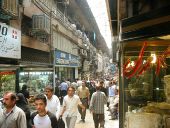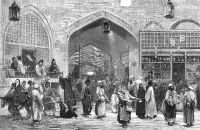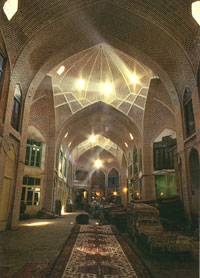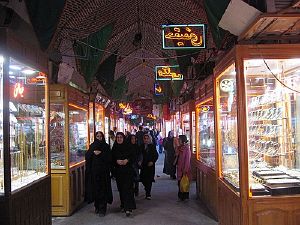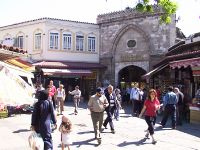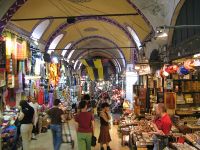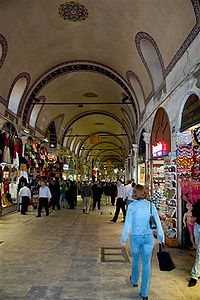Difference between revisions of "Bazaar" - New World Encyclopedia
(Claimed) |
(updated & fixed) |
||
| Line 2: | Line 2: | ||
[[Category:Anthropology]] | [[Category:Anthropology]] | ||
{{Claimed}} | {{Claimed}} | ||
| − | |||
| + | [[Image:Bd bazaar.jpg|thumb|Bazaar in [[Bangladesh]]]] | ||
| + | [[Image:Istanbul grand bazar 1.jpg|thumb|[[Grand Bazaar]], [[Istanbul]]]] | ||
| + | {{for|other articles called Bazaar|Bazaar (disambiguation)}} | ||
| − | A '''bazaar''' ( | + | A '''bazaar''' ({{lang-fa|بازار}}) is a permanent merchandising area, [[marketplace]], or street of shops where goods and services are exchanged or sold. The word derives from the Persian word ''bāzār'', the etymology of which goes back to the [[Middle Persian|Pahlavi]] word ''baha-char'' (بهاچار) meaning "the place of prices".<ref>{{cite web |
| + | | url = http://dictionary.reference.com/browse/bazaar | ||
| + | | title = bazaar | ||
| + | | accessdate = 2007-02-17 | ||
| + | }} | ||
| + | </ref> Although the current meaning of the word is believed to have originated in [[Persia]], its use has spread and now has been accepted into the vernacular in countries around the world.<ref>{{cite web | ||
| + | |url=http://dsal.uchicago.edu/cgi-bin/philologic/getobject.pl?c.0:1:171.hobson | ||
| + | |title=BAZAAR s. H. &c. From P. bāzār, a permanent market or street of shops. | ||
| + | |publisher=University of Chicago | ||
| + | |accessdate=2007-07-19 | ||
| + | }}</ref> | ||
| + | [[Image:Paharganj main bazaar.jpg|thumb|Bazaar in [[Dehli]], [[India]]]] | ||
| − | == | + | == Examples == |
| − | |||
| − | The | + | ===The Old Bazaar in Cairo=== |
| − | |||
| − | + | [[Image:Khan El Khalili bazar.jpg|thumb|right|180px|Khan El Khalili Bazar]] | |
| + | '''Khan el-Khalili''' ([[Arabic language|Arabic]]: خان الخليلي) is a major ''[[souk|souq]]'' in the Old City of [[Cairo]]. | ||
| − | The | + | The district is a major tourist attraction, and is considered by many, tourists and natives alike, to be one of the most interesting parts of Cairo. It is mostly shops, but some of the shops have also their own little factories or workshops. |
| − | + | The ''souq'' dates back to 1382, when [[Emir]] Djaharks el-Khalili built a large [[caravanserai]] (خان ''khan'' in Arabic) in Cairo under the [[Burji Mamluks|Burji]] [[Mamluk]] [[Sultan of Egypt|Sultan]] [[Barquq]]; the eponymous ''khan'' is still extant. | |
| − | + | The ''souq'' is noted for selling good-quality [[clothing]], [[cloth]], [[spice]]s, [[souvenir]]s, and traditional [[jewelry]] and [[perfume]]s at reasonable prices. Imitation Western perfumes are also produced, but tend to be of inferior quality. | |
| − | |||
| − | |||
| − | |||
| − | |||
| − | |||
| − | |||
| − | |||
| − | |||
| − | + | In addition to shops, there are several Arabic [[coffeehouse]]s (مقهى ''maqha'' or قهوة ''qahwah'', depending on dialect), restaurants, and [[street food]] vendors distributed throughout the market. The coffeeshops are generally small and quite traditional, serving [[Turkish coffee]] and usually offering [[shisha]]. The [[Al-Hussein Mosque]] is also in Khan El-Khalili; [[Al-Azhar University]] and its mosque are not far away. | |
| + | |||
| + | [[Naguib Mahfouz]]'s novel ''[[Midaq Alley (novel)|Midaq Alley]]'' was set in an alley in Khan El-Khalili. | ||
| + | |||
| + | The market was a target for terrorism during the [[April 2005 terrorist attacks in Cairo|spate of attacks in Cairo]] in April 2005. The suicide attack in the market, on 7 April, took 21 lives (eleven Egyptians, two [[France|French]] tourists, one [[United States|American]], and seven foreigners of unidentified origin). It was the first attack in the series; this attack scared away tourists from Egypt in general and Khan El-Khalili in particular for some time. The market has yet to recover its former tourist business. | ||
| + | |||
| + | |||
| + | |||
| + | ===Tehran's Grand Bazaar=== | ||
| + | |||
| + | [[Image:Bazar_in_Tehran.PNG|thumb|300px|right|Location of Tehran Grand Bazar neighborhood (black) in Municipal District No. 12 (dark grey) of Tehran metropolis]] | ||
| + | |||
| + | [[Image:Iran 012.jpg|thumb|right|170px|Although [[Tehran's Grand Bazaar]] economic influence has diminished somewhat in recent years, it remains the largest market of its kind in the world.]] | ||
| + | |||
| + | '''Tehran's Grand Bazaar''', is the world's largest bazaar situated in the capital of [[Iran]], [[Tehran]]. | ||
| + | |||
| + | |||
| + | A bazaar is a type of marketplace, although many - such as Tehran's Grand bazaar - fulfill many additional functions rather than merely trade. Throughout its history, the Grand bazaar has played host to [[Bank|banks]] and financiers, [[Mosque|mosques]] and [[Guest house|guest houses]]. | ||
| + | |||
| + | [[Trade]] is, however, the key aspect of the bazaar. Traditionally, the Tehran bazaar was split into corridors, each specializing in different types of goods, including [[copper]], [[carpets]], [[paper]], [[spices]], and [[precious metals]], as well as small traders selling all types of goods.<ref>[http://www.artarena.force9.co.uk/thrnsites.htm "Iransaga - Some Places of Interest in Tehran"]</ref> Today, modern goods are available as well, in addition to the many traditional corridor traders that still survive.<ref>[http://news.bbc.co.uk/1/hi/world/middle_east/645192.stm "BBC News - Tehran bazaar feels winds of change"]{</ref> | ||
| + | |||
| + | The Grand Bazaar is located in southern Tehran; its many corridors are over 10km in length. There are several entrances, some of which are locked and guarded at night.<ref>[http://www.itto.org/attraction/attraction.asp?status=showattraction&attractid=Te102&prv=teh "About Tehran Bazaar in Tehran province"]</ref> | ||
| + | |||
| + | [[Image:Tehran Bazaar old.jpg|thumb|right|200px|An 1873 illustration of Tehran's bustling Bazaar.]] | ||
| + | While the current bazaar is most associated with the 19th century onwards, its roots go back much further. | ||
| + | |||
| + | ==== Trade and Early Bazaars in Tehran ==== | ||
| + | |||
| + | The area around Tehran has been settled since at least 6000 B.C.E., and while bazaar-like construction in Iran as a whole has been dated as far back as 4000 B.C.E., Tehran's bazaar is not this old. It is hard to say exactly when the "bazaar" first appeared, but in the centuries following the introduction of [[Islam]], travellers reported the growth of commerce in the area now occupied by the current bazaar. The Grand bazaar is a continuation of this legacy. | ||
| + | |||
| + | Research indicates that a portion of today's bazaar predated the growth of the village of Tehran under the [[Safavids]]' dynasty, although it was during and after this period that the bazaar began to grow gradually. | ||
| + | |||
| + | Western travellers indicated that by 1660 C.E. and beyond, the bazaar area was still largely open, and only partially covered.<ref>[http://www.irvl.net/IRAN38.HTM Moghaddam, Abbas "Bazaar, the achievement of the Islamic civilisation. A short history of the Tehran Bazaar" from The Newsletter of Chamber of Commerce, Feb. 1994 (Chamber of Commerce, Industries & Mines of the Islamic Republic of Iran)]</ref> | ||
| + | |||
| + | ==== Development; The Grand Bazaar proper ==== | ||
| + | |||
| + | Despite relying heavily on this historical legacy, much of the bazaar itself was constructed fairly recently. The oldest remaining buildings, walls and passages in the bazaar today very rarely exceed 400 years, with many being constructed or rebuilt within the last 200 years. In this sense, the current grand bazaar is one of the newest in the [[Middle East]]. | ||
| + | |||
| + | The bazaar grew as a "city within a city" for much of the 19th century, and was largely able to expand itself without much outside interference. However, as Tehran began to grow exponentially in the early 20th century under [[Reza Shah]], the changes brought by this rapid expansion saw much of the bazaar (including such areas as the Perfume Sellers' Bazaar and Moat Bazaar) disappear. | ||
| + | |||
| + | The old sections of the bazaar are generally similar in [[Iranian architecture|architectural style]], while parts added in the 20th century often look markedly different; critics say that less care was taken in the construction of later sections. However, in an effort to increase the prestige of the bazaar, projects to beautify the bazaar through the use of plaster moulding and decorative brickwork were undertaken late in the 20th century. | ||
| + | |||
| + | ==== The Bazaari and the Islamic Revolution ==== | ||
| + | |||
| + | |||
| + | |||
| + | The bazaar is viewed as a force of conservatism in Iranian society, providing strong links between the clergy and the middle class traders. The [[Iranian Revolution]] of 1979 received strong backing from these forces. As one of the most important bazaars in the country, the Tehran Grand Bazaar was a center of pro-revolutionary feeling and finance. | ||
| + | |||
| + | There were several reasons why the bazaar class worked hard to help advance the revolution. The regime of the monarch [[Mohammed Reza Pahlavi]] was anathema to the bazaaris, who seemed set to lose out as the country industrialised; they feared that they would be left behind and their status in society would be reduced. | ||
| + | |||
| + | Similarly, another concern for the "bazaar class," not just in Tehran but throughout Iran, was that these traditional economic forces did not benefit from the 1974-1978 oil boom, and were thus even more inclined to aid the revolution.<ref>[http://www.photius.com/countries/iran/economy/iran_economy_oil_revenues_and_the~8981.html - "Iran Oil Revenues and the Acceleration of Modernization, 1960-79"]</ref> | ||
| + | |||
| + | As such, the Grand Bazaar in Tehran was a hotbed of support for the revolution, which positioned itself opposite the pro-Western monarchy. The Grand Bazaar continues largely to support the establishment, particularly as conservative political forces often adopt a low tax, laissez-faire approach to bazaaris.<ref>[http://news.bbc.co.uk/1/hi/world/middle_east/138125.stm "Who is the mayor of Tehran?"]</ref> | ||
| + | ==== The Bazaar Today ==== | ||
| + | [[Image:Iran 016.jpg|thumb]] | ||
| + | The Grand bazaar is still an important place of commerce for Tehranis, Iranians, travelling merchants and - increasingly - tourists. However, much of the trade and finance in the city has moved to the [[Shemiran|north of the city]], leaving the bazaar somewhat decreased in importance. Still, in addition to the traditional goods on sale, the market for watches and local jewelry is apparently growing, most likely for the benefits of tourists. As is in keeping with the market spirit, tourists are encouraged to haggle. The bazaar sees the peak of its business at midday and between 5 and 7 in the evening. | ||
| + | |||
| + | As of October 2005, plans are in place to construct a hotel in the southern section of the bazaar for the benefit of tourists, in a bid to make the bazaar more hospitable and to regain some of its importance.<ref>[http://www.iran-daily.com/1384/2399/html/panorama.htm "Iran Daily: Tehran Grand Bazaar To Get Facelift (Oct 12 2005)] | ||
| + | </ref> | ||
| + | |||
| + | ===Bazaar of Tabriz, Iran=== | ||
| + | |||
| + | [[Image:Bazar.jpg|thumb|right|An aley in Tabriz Bazaar (special alley for carpet selling).]] | ||
| + | The '''Bazaar of Tabriz''', located in the centre of the city of [[Tabriz]], [[Iran]], is one of the oldest and largest [[bazaar]]s in the [[Middle East]]. It is said that it is the largest closed one-roofed structure in the world.{{Fact|date=July 2007}} | ||
| + | |||
| + | The Bazaar of Tabriz has a very good outlook. It consists of some sub-bazaars in various fields, including Amir Bazaar (for gold and jewellery), a shoe bazaar, Mozzafarieh (carpet bazaar) and many other subdivisions for special matters. | ||
| + | In modern times in which numerous modern shops and malls have been established, the Bazaar remains as the economic heart of Tabriz. It is also used for the celebration of special ceremonies (especially [[Ashura]]). | ||
| + | |||
| + | Like other middle-eastern Bazaars, there are a numbers of mosques constructed behind the bazaar. Jome Mosque is the most notable of these. | ||
| + | [[Image:Tabriz_AmirBZR.jpg|thumb|right|Amir alley in Tabriz Bazar.]] | ||
| + | |||
| + | |||
| + | |||
| + | |||
| + | |||
| + | ===Bazaar of Isfahan, Iran=== | ||
| + | [[Image:Esfahan bazaar entrance.jpg|thumb|right|One of several entrances of the Isfahan Bazaar.]]The '''Bazaar of [[Isfahan (city)|Isfahan]]''' is one of the oldest and largest [[bazaar]]s of the [[Middle East]], dating back to the 17th century C.E. The bazaar is a vaulted two kilometer street linking the old city with the new.<ref>{{cite web | ||
| + | |url=http://archnet.org/library/sites/one-site.tcl?site_id=3945 | ||
| + | |title=Bazaar at Isfahan | ||
| + | |publisher=Archnet.org | ||
| + | |accessdate=2007-07-19 | ||
| + | }}</ref> | ||
| + | |||
| + | |||
| + | |||
| + | |||
| + | ===The Grand Bazaar, Istanbul=== | ||
| + | |||
| + | [[Image:Grand-bazaar-istanbul-june-2005.jpg|thumb|right|200px|A view from the entrance]] | ||
| + | [[Image:Istanbul grand bazar 1.jpg|thumb|right|200px|The Grand Bazaar]] | ||
| + | The '''Grand Bazaar''' (or '''Covered Bazaar''', {{lang-tr|Kapalıçarşı}} ("Covered Bazaar")<!-- wrote twice once for aka, the other for Turkish name's translation-->) in [[Istanbul]] is one of the largest [[Bazaar|covered markets]] in the world with more than 58 streets and 4,000 shops, and has between 250,000 and 400,000 visitors daily. It is well known for its jewelry, pottery, spice, and carpet shops. Many of the stalls in the bazaar are grouped by type of goods, with special areas for leather coats, gold jewelry and the like. The bazaar contains two ''bedesten''s (domed masonry structures built for storage and safe keeping), the first of which was constructed between 1455 and 1461 by the order of Sultan [[Mehmed II|Mehmed the Conqueror]]. The bazaar was vastly enlarged in the 16th century, during the reign of Sultan [[Suleiman the Magnificent]], and in 1894 underwent a major restoration following an earthquake. | ||
| + | |||
| + | |||
| + | [[Image:Grand_bazaar_interior.jpg|thumb|right|200px|The Grand Bazaar is a massive labyrinth of 4000 shops lining up the flanks of 58 covered streets]] | ||
| + | '''Inner Bedesten''' : It was the first building to rise in Kapalıçarşı, actually it is the Old Bedestan which forms the backbone of the bazaar. The names of the gates are: Bouquinistes, Hat Shops, Jewelry Shops and Costume Shops. | ||
| + | |||
| + | '''Sandal Bedesten''' : It has the most number of domes in Kapalıçarşı. At present it can be accessed through two gates, one is through the main gate and the other is through the Nuruosmaniye district. | ||
| + | |||
| + | '''Other sections of the Grand Bazaar''': The architectural design of the roads making up other sections apart from the two bedestens is not symmetrical and geometrical; it has a scattered nature due to its formation which took many centuries with new parts being added. In this way, it stays away from the closed bazaar style of the West and has a character of an Oriental bazaar. This laid back settlement and scattered nature prevents the bazaar from being dull, and at the same time gives it a romantic flavour. Such a complicated structure and settlement not only maintains the monumental state of the bazaar, but also makes it a palace for shopping. | ||
| + | |||
| + | |||
| + | The Grand Bazaar has four main gates situated at the ends of its two major streets which intersect near the southwestern corner of the bazaar. One street combines the [[Bayezid II Mosque]] and Bayezid Square with Nuruosmaniye Mosque. | ||
| + | |||
| + | |||
| + | |||
| + | |||
| + | ==Notes== | ||
| + | <references/> | ||
| + | |||
| + | ==References== | ||
| + | |||
| + | *Gregorian, Vartan (2003). ''The Road to Home: My Life and Times''. New York: Simon & Shuster. | ||
| + | *Levinson, David and Karen Christensen (2002). ''Encyclopedia of Modern Asia''. New York: Scribner's. | ||
| + | *Swiętochowski, Thaddeus (1995). '' Russia and Azerbaijan: A Borderland in Transition''. New York: Columbia University Press. | ||
| + | * | ||
==External links== | ==External links== | ||
*[http://www.iranchamber.com/architecture/bazaar_of_isfahan1.php Iran Chamber Society on Architecture of the Bazaar at Isfahan] | *[http://www.iranchamber.com/architecture/bazaar_of_isfahan1.php Iran Chamber Society on Architecture of the Bazaar at Isfahan] | ||
| + | *[http://www.1911encyclopedia.org/Bazaar 1911 Britannica article "Bazaar"] | ||
| + | |||
| + | |||
| + | *[http://www.bbc.co.uk/persian/iran/story/2007/07/070716_ag-tehran-iran-bazar.shtml Pictures of the Grand Bazaar on BBC] | ||
| + | *[http://www.nivas.com/pics/albums/Iran/Nov%202002%20Sawhney%20Nivas/normal_IMG_1373_JPG.jpg Grand Bazaar in Tehran] | ||
| + | *[http://www.nivas.com/pics/albums/Iran/Nov%202002%20Sawhney%20Nivas/normal_IMG_1374_JPG.jpg Tehran's Grand Bazaar Perfume Shop] | ||
| + | *[http://www.nivas.com/pics/albums/Iran/Nov%202002%20Sawhney%20Nivas/normal_IMG_1372_JPG.jpg Tehran's Grand Bazaar Herb Shop] | ||
| + | *[http://www.nivas.com/pics/albums/Iran/Nov%202002%20Sawhney%20Nivas/normal_IMG_1383_JPG.jpg Tehran's Grand Bazaar Gold Market] | ||
| + | |||
| + | |||
| + | *[http://www.iranchamber.com/architecture/bazaar_of_isfahan1.php Iran Chamber Society on Architecture of the Bazaar at Isfahan] | ||
| + | |||
| + | * [http://www.kapalicarsi.org.tr/index.php Kapalıçarşı - Grand Bazaar] | ||
| + | * [http://www.kultur.gov.tr/EN/BelgeGoster.aspx?17A16AE30572D313F88F742D0D711251AD9C4ADBD3E2D17A Republic of Turkey Ministry of Culture] | ||
| + | * [http://www.mymerhaba.com/en/main/content.asp_Q_id_E_132 My Merhaba] | ||
| + | * [http://newspot.byegm.gov.tr/arsiv/2001/nov-dec/n14.htm Newspot] | ||
| + | * [http://travel.webshots.com/album/552169060CQolrY Webshots album] | ||
| + | * [http://english.istanbul.com/explorenew.asp?cat=16 Istanbul.com] | ||
| + | * [http://http://www.jozan.net/2005/Grand-Bazaar.asp Carpet shops] | ||
| + | * [http://http://www.grandbazaar.org Grand Bazaar on Net] | ||
| + | |||
| + | * Archnet Digital Library - [http://archnet.org/library/sites/one-site.tcl?site_id=7441 ''Covered Bazaar''] | ||
| + | * Let's Go Istanbul - [http://www.letsgoistanbul.com/covered.htm ''Istanbul Covered Bazaar''] | ||
| + | * Turkish Culture Portal - [http://www.turkishculture.org/pages.php?ParentID=6&ID=98 ''Grand Bazaar in Istanbul''] | ||
| + | |||
| + | |||
| + | |||
| + | |||
| + | |||
| − | + | {{Credits|Bazaar|157503791|Khan_El-Khalili|155550602|Tehran's_Grand_Bazaar|151715007|Bazaar_of_Tabriz|156368676|Bazaar_of_Isfahan|145781530|Grand_Bazaar,_Istanbul|157415988|}} | |
| − | {{ | ||
Revision as of 16:57, 13 September 2007


A bazaar (Persian: بازار) is a permanent merchandising area, marketplace, or street of shops where goods and services are exchanged or sold. The word derives from the Persian word bāzār, the etymology of which goes back to the Pahlavi word baha-char (بهاچار) meaning "the place of prices".[1] Although the current meaning of the word is believed to have originated in Persia, its use has spread and now has been accepted into the vernacular in countries around the world.[2]

Examples
The Old Bazaar in Cairo
Khan el-Khalili (Arabic: خان الخليلي) is a major souq in the Old City of Cairo.
The district is a major tourist attraction, and is considered by many, tourists and natives alike, to be one of the most interesting parts of Cairo. It is mostly shops, but some of the shops have also their own little factories or workshops.
The souq dates back to 1382, when Emir Djaharks el-Khalili built a large caravanserai (خان khan in Arabic) in Cairo under the Burji Mamluk Sultan Barquq; the eponymous khan is still extant.
The souq is noted for selling good-quality clothing, cloth, spices, souvenirs, and traditional jewelry and perfumes at reasonable prices. Imitation Western perfumes are also produced, but tend to be of inferior quality.
In addition to shops, there are several Arabic coffeehouses (مقهى maqha or قهوة qahwah, depending on dialect), restaurants, and street food vendors distributed throughout the market. The coffeeshops are generally small and quite traditional, serving Turkish coffee and usually offering shisha. The Al-Hussein Mosque is also in Khan El-Khalili; Al-Azhar University and its mosque are not far away.
Naguib Mahfouz's novel Midaq Alley was set in an alley in Khan El-Khalili.
The market was a target for terrorism during the spate of attacks in Cairo in April 2005. The suicide attack in the market, on 7 April, took 21 lives (eleven Egyptians, two French tourists, one American, and seven foreigners of unidentified origin). It was the first attack in the series; this attack scared away tourists from Egypt in general and Khan El-Khalili in particular for some time. The market has yet to recover its former tourist business.
Tehran's Grand Bazaar
Tehran's Grand Bazaar, is the world's largest bazaar situated in the capital of Iran, Tehran.
A bazaar is a type of marketplace, although many - such as Tehran's Grand bazaar - fulfill many additional functions rather than merely trade. Throughout its history, the Grand bazaar has played host to banks and financiers, mosques and guest houses.
Trade is, however, the key aspect of the bazaar. Traditionally, the Tehran bazaar was split into corridors, each specializing in different types of goods, including copper, carpets, paper, spices, and precious metals, as well as small traders selling all types of goods.[3] Today, modern goods are available as well, in addition to the many traditional corridor traders that still survive.[4]
The Grand Bazaar is located in southern Tehran; its many corridors are over 10km in length. There are several entrances, some of which are locked and guarded at night.[5]
While the current bazaar is most associated with the 19th century onwards, its roots go back much further.
Trade and Early Bazaars in Tehran
The area around Tehran has been settled since at least 6000 B.C.E., and while bazaar-like construction in Iran as a whole has been dated as far back as 4000 B.C.E., Tehran's bazaar is not this old. It is hard to say exactly when the "bazaar" first appeared, but in the centuries following the introduction of Islam, travellers reported the growth of commerce in the area now occupied by the current bazaar. The Grand bazaar is a continuation of this legacy.
Research indicates that a portion of today's bazaar predated the growth of the village of Tehran under the Safavids' dynasty, although it was during and after this period that the bazaar began to grow gradually.
Western travellers indicated that by 1660 C.E. and beyond, the bazaar area was still largely open, and only partially covered.[6]
Development; The Grand Bazaar proper
Despite relying heavily on this historical legacy, much of the bazaar itself was constructed fairly recently. The oldest remaining buildings, walls and passages in the bazaar today very rarely exceed 400 years, with many being constructed or rebuilt within the last 200 years. In this sense, the current grand bazaar is one of the newest in the Middle East.
The bazaar grew as a "city within a city" for much of the 19th century, and was largely able to expand itself without much outside interference. However, as Tehran began to grow exponentially in the early 20th century under Reza Shah, the changes brought by this rapid expansion saw much of the bazaar (including such areas as the Perfume Sellers' Bazaar and Moat Bazaar) disappear.
The old sections of the bazaar are generally similar in architectural style, while parts added in the 20th century often look markedly different; critics say that less care was taken in the construction of later sections. However, in an effort to increase the prestige of the bazaar, projects to beautify the bazaar through the use of plaster moulding and decorative brickwork were undertaken late in the 20th century.
The Bazaari and the Islamic Revolution
The bazaar is viewed as a force of conservatism in Iranian society, providing strong links between the clergy and the middle class traders. The Iranian Revolution of 1979 received strong backing from these forces. As one of the most important bazaars in the country, the Tehran Grand Bazaar was a center of pro-revolutionary feeling and finance.
There were several reasons why the bazaar class worked hard to help advance the revolution. The regime of the monarch Mohammed Reza Pahlavi was anathema to the bazaaris, who seemed set to lose out as the country industrialised; they feared that they would be left behind and their status in society would be reduced.
Similarly, another concern for the "bazaar class," not just in Tehran but throughout Iran, was that these traditional economic forces did not benefit from the 1974-1978 oil boom, and were thus even more inclined to aid the revolution.[7]
As such, the Grand Bazaar in Tehran was a hotbed of support for the revolution, which positioned itself opposite the pro-Western monarchy. The Grand Bazaar continues largely to support the establishment, particularly as conservative political forces often adopt a low tax, laissez-faire approach to bazaaris.[8]
The Bazaar Today
The Grand bazaar is still an important place of commerce for Tehranis, Iranians, travelling merchants and - increasingly - tourists. However, much of the trade and finance in the city has moved to the north of the city, leaving the bazaar somewhat decreased in importance. Still, in addition to the traditional goods on sale, the market for watches and local jewelry is apparently growing, most likely for the benefits of tourists. As is in keeping with the market spirit, tourists are encouraged to haggle. The bazaar sees the peak of its business at midday and between 5 and 7 in the evening.
As of October 2005, plans are in place to construct a hotel in the southern section of the bazaar for the benefit of tourists, in a bid to make the bazaar more hospitable and to regain some of its importance.[9]
Bazaar of Tabriz, Iran
The Bazaar of Tabriz, located in the centre of the city of Tabriz, Iran, is one of the oldest and largest bazaars in the Middle East. It is said that it is the largest closed one-roofed structure in the world.[citation needed]
The Bazaar of Tabriz has a very good outlook. It consists of some sub-bazaars in various fields, including Amir Bazaar (for gold and jewellery), a shoe bazaar, Mozzafarieh (carpet bazaar) and many other subdivisions for special matters. In modern times in which numerous modern shops and malls have been established, the Bazaar remains as the economic heart of Tabriz. It is also used for the celebration of special ceremonies (especially Ashura).
Like other middle-eastern Bazaars, there are a numbers of mosques constructed behind the bazaar. Jome Mosque is the most notable of these.
Bazaar of Isfahan, Iran
The Bazaar of Isfahan is one of the oldest and largest bazaars of the Middle East, dating back to the 17th century C.E. The bazaar is a vaulted two kilometer street linking the old city with the new.[10]
The Grand Bazaar, Istanbul
The Grand Bazaar (or Covered Bazaar, Turkish: Kapalıçarşı ("Covered Bazaar")) in Istanbul is one of the largest covered markets in the world with more than 58 streets and 4,000 shops, and has between 250,000 and 400,000 visitors daily. It is well known for its jewelry, pottery, spice, and carpet shops. Many of the stalls in the bazaar are grouped by type of goods, with special areas for leather coats, gold jewelry and the like. The bazaar contains two bedestens (domed masonry structures built for storage and safe keeping), the first of which was constructed between 1455 and 1461 by the order of Sultan Mehmed the Conqueror. The bazaar was vastly enlarged in the 16th century, during the reign of Sultan Suleiman the Magnificent, and in 1894 underwent a major restoration following an earthquake.
Inner Bedesten : It was the first building to rise in Kapalıçarşı, actually it is the Old Bedestan which forms the backbone of the bazaar. The names of the gates are: Bouquinistes, Hat Shops, Jewelry Shops and Costume Shops.
Sandal Bedesten : It has the most number of domes in Kapalıçarşı. At present it can be accessed through two gates, one is through the main gate and the other is through the Nuruosmaniye district.
Other sections of the Grand Bazaar: The architectural design of the roads making up other sections apart from the two bedestens is not symmetrical and geometrical; it has a scattered nature due to its formation which took many centuries with new parts being added. In this way, it stays away from the closed bazaar style of the West and has a character of an Oriental bazaar. This laid back settlement and scattered nature prevents the bazaar from being dull, and at the same time gives it a romantic flavour. Such a complicated structure and settlement not only maintains the monumental state of the bazaar, but also makes it a palace for shopping.
The Grand Bazaar has four main gates situated at the ends of its two major streets which intersect near the southwestern corner of the bazaar. One street combines the Bayezid II Mosque and Bayezid Square with Nuruosmaniye Mosque.
Notes
- ↑ bazaar. Retrieved 2007-02-17.
- ↑ BAZAAR s. H. &c. From P. bāzār, a permanent market or street of shops.. University of Chicago. Retrieved 2007-07-19.
- ↑ "Iransaga - Some Places of Interest in Tehran"
- ↑ "BBC News - Tehran bazaar feels winds of change"{
- ↑ "About Tehran Bazaar in Tehran province"
- ↑ Moghaddam, Abbas "Bazaar, the achievement of the Islamic civilisation. A short history of the Tehran Bazaar" from The Newsletter of Chamber of Commerce, Feb. 1994 (Chamber of Commerce, Industries & Mines of the Islamic Republic of Iran)
- ↑ - "Iran Oil Revenues and the Acceleration of Modernization, 1960-79"
- ↑ "Who is the mayor of Tehran?"
- ↑ "Iran Daily: Tehran Grand Bazaar To Get Facelift (Oct 12 2005)
- ↑ Bazaar at Isfahan. Archnet.org. Retrieved 2007-07-19.
ReferencesISBN links support NWE through referral fees
- Gregorian, Vartan (2003). The Road to Home: My Life and Times. New York: Simon & Shuster.
- Levinson, David and Karen Christensen (2002). Encyclopedia of Modern Asia. New York: Scribner's.
- Swiętochowski, Thaddeus (1995). Russia and Azerbaijan: A Borderland in Transition. New York: Columbia University Press.
External links
- Pictures of the Grand Bazaar on BBC
- Grand Bazaar in Tehran
- Tehran's Grand Bazaar Perfume Shop
- Tehran's Grand Bazaar Herb Shop
- Tehran's Grand Bazaar Gold Market
- Kapalıçarşı - Grand Bazaar
- Republic of Turkey Ministry of Culture
- My Merhaba
- Newspot
- Webshots album
- Istanbul.com
- Carpet shops
- Grand Bazaar on Net
- Archnet Digital Library - Covered Bazaar
- Let's Go Istanbul - Istanbul Covered Bazaar
- Turkish Culture Portal - Grand Bazaar in Istanbul
Credits
New World Encyclopedia writers and editors rewrote and completed the Wikipedia article in accordance with New World Encyclopedia standards. This article abides by terms of the Creative Commons CC-by-sa 3.0 License (CC-by-sa), which may be used and disseminated with proper attribution. Credit is due under the terms of this license that can reference both the New World Encyclopedia contributors and the selfless volunteer contributors of the Wikimedia Foundation. To cite this article click here for a list of acceptable citing formats.The history of earlier contributions by wikipedians is accessible to researchers here:
- Bazaar history
- Khan_El-Khalili history
- Tehran's_Grand_Bazaar history
- Bazaar_of_Tabriz history
- Bazaar_of_Isfahan history
- Grand_Bazaar,_Istanbul history
The history of this article since it was imported to New World Encyclopedia:
Note: Some restrictions may apply to use of individual images which are separately licensed.
